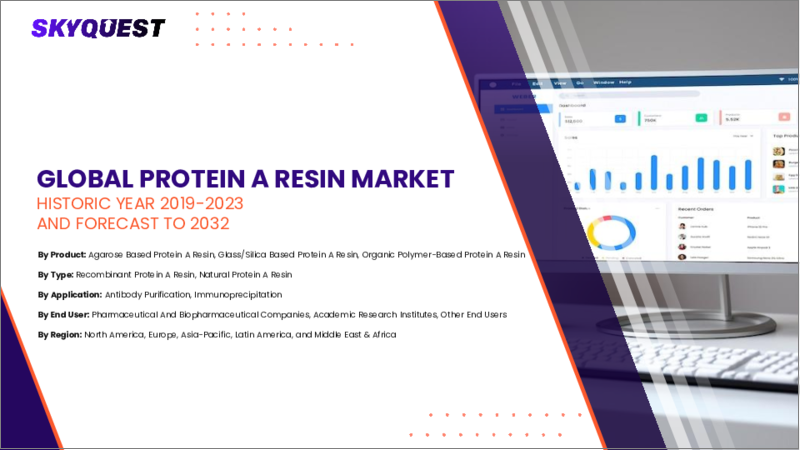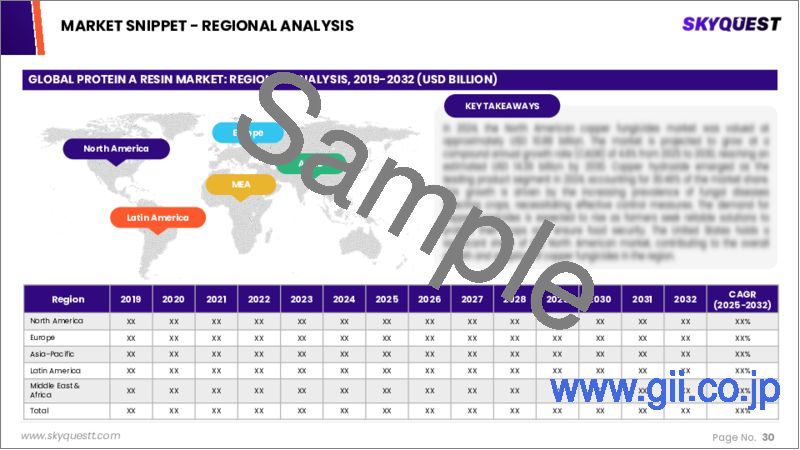|
|
市場調査レポート
商品コード
1593486
プロテインA樹脂の市場規模・シェア・成長分析 (製品種類別、プロテインAの種類別、用途別、エンドユーザー別、地域別):産業予測 (2024~2031年)Protein A Resin Market Size, Share, Growth Analysis, By Product (Agarose-Based Protein A, Glass/Silica-Based Protein A), By Protein A Type (Recombinant Protein A, Natural Protein A), By Application, By End User, By Region - Industry Forecast 2024-2031 |
||||||
|
|||||||
| プロテインA樹脂の市場規模・シェア・成長分析 (製品種類別、プロテインAの種類別、用途別、エンドユーザー別、地域別):産業予測 (2024~2031年) |
|
出版日: 2024年11月10日
発行: SkyQuest
ページ情報: 英文 162 Pages
納期: 3~5営業日
|
全表示
- 概要
- 目次
世界のプロテインA樹脂の市場規模は、2022年に12億3,000万米ドルと評価され、2023年の13億5,000万米ドルから2031年には28億6,000万米ドルに成長し、予測期間 (2024~2031年) のCAGRは9.81%に達する見通しです。
プロテインA樹脂市場は、治療用タンパク質の生産と強化に不可欠な高品質のバイオ製造プロセスの推進において重要な役割を果たしています。この市場は製薬・バイオテクノロジー分野の重要なコンポーネントであり、主に抗体や様々な治療用タンパク質の効率的な精製の必要性によって牽引されています。生物製剤、モノクローナル抗体、個別化医薬品に対する需要の急増に加え、バイオテクノロジーや生産手法の進歩が続いていることが、市場の成長を後押ししています。しかし、コストが高い、規制要件が厳しい、樹脂の寿命が限られているなどの課題が障害となっています。とはいえ、持続可能な実践へのシフト、個別化医療と生物製剤への注目の高まりに後押しされ、市場は今後数年で大きな成長を遂げると予想されます。こうした動向が進化を続ける中、プロテインA樹脂市場は、バイオ製造プロセスの革新と効率化にとって引き続き重要であり、最終的には救命治療の生産を強化することになります。
目次
イントロダクション
- 分析目的
- 定義
- 市場範囲
分析手法
- 情報調達
- 二次データソースと一次データソース
- 市場規模予測
- 市場の想定と制限
エグゼクティブサマリー
- 市場の概要と見通し
- 需給動向の分析
- セグメント別の機会分析
市場力学と見通し
- 市場力学
- 促進要因
- 機会
- 抑制要因
- 課題
- ポーターの分析
主な市場の考察
- 主な成功要因
- 競合の程度
- 主な投資機会
- 市場のエコシステム
- 規制情勢
- 技術分析
- 価格分析
- PESTEL分析
- 市場求心力指数 (2023年)
- ケーススタディ分析
プロテインA樹脂市場:製品別
- 市場概要
- アガロースベースのプロテインA
- ガラス/シリカベースのプロテインA
- 有機ポリマーベースのプロテインA
プロテインA樹脂市場:プロテインAの種類別
- 市場概要
- 組み換えタンパク質A
- 天然プロテインA
プロテインA樹脂市場:用途別
- 市場概要
- 抗体精製
- 免疫沈降法
プロテインA樹脂市場:エンドユーザー別
- 市場概要
- 製薬・バイオ医薬品企業
- 学術調査機関
- その他のエンドユーザー
プロテインA樹脂市場:地域別
- 市場概要
- 北米
- 米国
- カナダ
- 欧州
- ドイツ
- スペイン
- フランス
- 英国
- イタリア
- その他欧州
- アジア太平洋
- 中国
- インド
- 日本
- 韓国
- その他アジア太平洋
- ラテンアメリカ
- ブラジル
- その他ラテンアメリカ
- 中東・アフリカ (MEA)
- 湾岸協力会議 (GCC) 諸国
- 南アフリカ
- その他中東・アフリカ
競合情勢
- 上位5社の比較
- 主要企業の市場ポジショニング (2023年)
- 主な市場企業が採用した戦略
- 市場における最近の活動
- 主要企業の市場シェア (%、2023年)
主要企業プロファイル
- Danaher Corporation
- Thermo Fisher Scientific
- Merck Kgaa
- Repligen Corporation
- Tosoh Bioscience Llc
- Agilent Technologies, Inc.
- Ecolab
- Genscript
- Perkinelmer Inc.
- Bio-Rad Laboratories, Inc.
- Avantor, Inc.
- Suzhou Nanomicro Technology Co., Ltd.
- Transgen Biotech Co., Ltd.
- Kaneka Corporation
- Geno Technology, Inc
- Agarose Bead Technologies
- JSR Corporation
- Bio-Works
- Generon
- JNC Corporation
- Promega Corporation
Global Protein A Resin Market size was valued at USD 1.23 billion in 2022 and is poised to grow from USD 1.35 billion in 2023 to USD 2.86 billion by 2031, growing at a CAGR of 9.81% during the forecast period (2024-2031).
The Protein A resin market plays a vital role in advancing high-quality biomanufacturing processes essential for producing and enhancing therapeutic proteins. This market is a critical component of the pharmaceutical and biotechnology sectors, predominantly driven by the need for effective purification of antibodies and various therapeutic proteins. A surge in demand for biologics, monoclonal antibodies, and personalized medicines, alongside ongoing advancements in biotechnology and production methodologies, is propelling market growth. However, challenges such as high costs, stringent regulatory requirements, and the limited lifespan of resins pose obstacles. Nevertheless, the market is expected to experience significant growth in the coming years, propelled by a shift towards sustainable practices and an increasing focus on personalized medicine and biologics. As these trends continue to evolve, the Protein A resin market will remain crucial for the innovation and efficiency of biomanufacturing processes, ultimately enhancing the production of life-saving therapies.
Top-down and bottom-up approaches were used to estimate and validate the size of the Global Protein A Resin market and to estimate the size of various other dependent submarkets. The research methodology used to estimate the market size includes the following details: The key players in the market were identified through secondary research, and their market shares in the respective regions were determined through primary and secondary research. This entire procedure includes the study of the annual and financial reports of the top market players and extensive interviews for key insights from industry leaders such as CEOs, VPs, directors, and marketing executives. All percentage shares split, and breakdowns were determined using secondary sources and verified through Primary sources. All possible parameters that affect the markets covered in this research study have been accounted for, viewed in extensive detail, verified through primary research, and analyzed to get the final quantitative and qualitative data.
Global Protein A Resin Market Segmental Analysis
Global Protein A Resin Market is segmented by Product, Protein A Type, Application, End User, and Region. Based on Product, the market is segmented into Agarose-Based Protein A, Glass/Silica-Based Protein A, Organic Polymer-Based Protein A. Based on Protein A Type, the market is segmented into Recombinant Protein A, Natural Protein A. Based on Application, the market is segmented into Antibody Purification, Immunoprecipitation. Based on End User, the market is segmented into Pharmaceutical & Biopharmaceutical Companies, Academic Research Institutes, Other End Users. Based on region, the market is segmented into North America, Europe, Asia Pacific, Latin America and Middle East & Africa.
Driver of the Global Protein A Resin Market
Improvements in biotechnology significantly drive the Global Protein A Resin market by enhancing the efficiency and effectiveness of antibody purification processes. As biopharmaceutical companies prioritize high-quality production, the demand for advanced purification technologies, including affinity chromatography utilizing Protein A resin, continues to rise. Innovations in resin design, such as increased binding capacity and reduced non-specific interactions, contribute to higher yields and cost-effectiveness, appealing to both established and emerging biopharma sectors. Furthermore, advancements in automation and scale-up processes bolster the adoption of Protein A resin, ultimately supporting the growing need for monoclonal antibodies and personalized medicine development within a rapidly evolving landscape.
Restraints in the Global Protein A Resin Market
One significant market restraint for the Global Protein A Resin market is the limited lifespan of these resins, which can hinder their cost-effectiveness and operational efficiency. Protein A resins, essential for the purification of antibodies and other proteins, often require regular replacement or regeneration due to factors such as steric hindrance, damage from cleaning procedures, or unsatisfactory binding capacity over time. This reduces the overall yield and increases the operational costs for companies relying on these resins in biopharmaceutical production. Consequently, the necessity for frequent maintenance and replacement may deter potential users and stifle market growth.
Market Trends of the Global Protein A Resin Market
The Global Protein A Resin market is witnessing a significant trend towards enhanced resin design and chemistry, driven by innovations aimed at increasing binding capabilities and reducing costs in antibody purification processes. Recent advancements in resin matrices and ligand chemistry have led to the development of highly stable ligands that withstand rigorous regeneration and cleaning protocols, thereby improving resin performance and longevity. Additionally, ongoing research into non-conventional ligands is opening new avenues for achieving similar binding efficiencies while minimizing dependence on traditional resins. This evolution is anticipated to propel market growth, increasing efficiency and cost-effectiveness across biopharmaceutical manufacturing.
Table of Contents
Introduction
- Objectives of the Study
- Definitions
- Market Scope
Research Methodology
- Information Procurement
- Secondary & Primary Data Sources
- Market Size Estimation
- Market Assumptions & Limitations
Executive Summary
- Market Overview Outlook
- Supply Demand Trend Analysis
- Segmental Opportunity Analysis
Market Dynamics & Outlook
- Market Dynamics
- Drivers
- Opportunities
- Restraints
- Challenges
- Porters Analysis
- Competitive rivalry
- Threat of Substitute Products
- Bargaining Power of Buyers
- Threat of New Entrants
- Bargaining Power of Suppliers
Key Market Insights
- Key Success Factor
- Degree of Competition
- Top Investment Pockets
- Ecosystem of the Market
- Regulatory Landscape
- Technology Analysis
- Pricing Analysis
- PESTEL Analysis
- Market Attractiveness Index, 2023
- Case Study Analysis
Protein A Resin Market, By Product
- Market Overview
- Agarose-Based Protein A
- Glass/Silica-Based Protein A
- Organic Polymer-Based Protein A
Protein A Resin Market, By Protein A Type
- Market Overview
- Recombinant Protein A
- Natural Protein A
Protein A Resin Market, By Application
- Market Overview
- Antibody Purification
- Immunoprecipitation
Protein A Resin Market, By End User
- Market Overview
- Pharmaceutical And Biopharmaceutical Companies
- Academic Research Institutes
- Other End Users
Protein A Resin Market Size by Region
- Market Overview
- North America
- USA
- Canada
- Europe
- Germany
- Spain
- France
- UK
- Italy
- Rest of Europe
- Asia Pacific
- China
- India
- Japan
- South Korea
- Rest of Asia-Pacific
- Latin America
- Brazil
- Rest of Latin America
- Middle East & Africa (MEA)
- GCC Countries
- South Africa
- Rest of MEA
Competitive Landscape
- Top 5 Player Comparison
- Market Positioning of Key Players, 2023
- Strategies Adopted by Key Market Players
- Recent Activities in the Market
- Key Companies Market Share (%), 2023
Key Company Profiles
- Danaher Corporation
- Company Overview
- Business Segment Overview
- Financial Updates
- Key Developments
- Thermo Fisher Scientific
- Company Overview
- Business Segment Overview
- Financial Updates
- Key Developments
- Merck Kgaa
- Company Overview
- Business Segment Overview
- Financial Updates
- Key Developments
- Repligen Corporation
- Company Overview
- Business Segment Overview
- Financial Updates
- Key Developments
- Tosoh Bioscience Llc
- Company Overview
- Business Segment Overview
- Financial Updates
- Key Developments
- Agilent Technologies, Inc.
- Company Overview
- Business Segment Overview
- Financial Updates
- Key Developments
- Ecolab
- Company Overview
- Business Segment Overview
- Financial Updates
- Key Developments
- Genscript
- Company Overview
- Business Segment Overview
- Financial Updates
- Key Developments
- Perkinelmer Inc.
- Company Overview
- Business Segment Overview
- Financial Updates
- Key Developments
- Bio-Rad Laboratories, Inc.
- Company Overview
- Business Segment Overview
- Financial Updates
- Key Developments
- Avantor, Inc.
- Company Overview
- Business Segment Overview
- Financial Updates
- Key Developments
- Suzhou Nanomicro Technology Co., Ltd.
- Company Overview
- Business Segment Overview
- Financial Updates
- Key Developments
- Transgen Biotech Co., Ltd.
- Company Overview
- Business Segment Overview
- Financial Updates
- Key Developments
- Kaneka Corporation
- Company Overview
- Business Segment Overview
- Financial Updates
- Key Developments
- Geno Technology, Inc
- Company Overview
- Business Segment Overview
- Financial Updates
- Key Developments
- Agarose Bead Technologies
- Company Overview
- Business Segment Overview
- Financial Updates
- Key Developments
- JSR Corporation
- Company Overview
- Business Segment Overview
- Financial Updates
- Key Developments
- Bio-Works
- Company Overview
- Business Segment Overview
- Financial Updates
- Key Developments
- Generon
- Company Overview
- Business Segment Overview
- Financial Updates
- Key Developments
- JNC Corporation
- Company Overview
- Business Segment Overview
- Financial Updates
- Key Developments
- Promega Corporation
- Company Overview
- Business Segment Overview
- Financial Updates
- Key Developments






